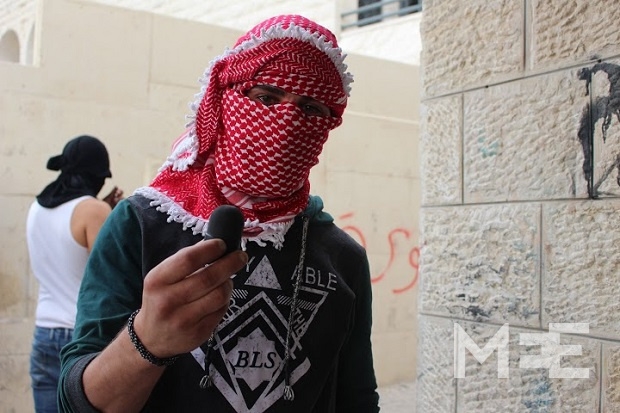Israeli forces crack down on Bethlehem during Jewish holiday

Israeli forces invaded Bethlehem on Thursday with military jeeps and flatbed trucks, cutting down trees and blocking streets with large square stones in preparation for the anniversary of the death of the venerated Jewish matriarch Rachel.
Locals told Middle East Eye that forces cut down trees in Aida refugee camp and on the main road for “better visibility” around the two areas where clashes normally take place. An Israeli army spokesperson did not confirm or deny the reasoning.
Meanwhile, cranes positioned large stone block barricades, closing off parts of the refugee camp, as well as several streets that lead to the city’s only checkpoint into Israel that is accessible to Palestinian workers.
Israeli authorities announced on Thursday that the checkpoint would be closed for three days during the holiday, barring hundreds of Palestinians from using the checkpoint to get to work in Israel.
The city of Bethlehem in the southern occupied West Bank is Area A territory, and under full Palestinian Authority (PA) control, however the Israeli military often enters the city through a large garage-like door in the separation wall. The door is located in the northern part of the city, right next to Rachel’s Tomb, which sits on the other side.
Clashes along that sector of the wall have been ongoing for 22 consecutive days, with young men fiercely clashing with Israeli forces every afternoon.
Clashes near Rachel’s Tomb
On Friday, the eve of the upcoming Jewish holiday, during which thousands of worshippers reportedly visited Rachel’s Tomb, Israeli forces seemed determined to keep the clashes as controlled and quiet as possible.
While Israeli forces generally rely on tear gas as one of its main crowd dispersal methods at the Bethlehem clashes, the forces used the gas sparingly at Friday’s demonstration.
“They’re shooting these sponge rounds today instead,” one protester, who wore a red Palestinian scarf wrapped tightly around his face said. “They don’t want to use the gas much because it could blow over to Rachel’s tomb where all the Jews are praying, and the gas is also a lot louder - they want it quiet here today.”
The sponge rounds, or “matatas” as the protesters call them in Arabic, are plastic and sponge cylinders about an inch and a half wide and two inches long. The rounds are shot at high velocity and have the capability of fracturing bones if hit at close range.
An Israeli army spokesperson would not comment on the use of sponge rounds at the protest.
“I can tell you violent riots took place [on the other side of the wall] near Rachel’s Tomb,” an Israeli army spokesperson told MEE, adding that Israeli forces used live fire during part of the protest, shooting and injuring at least one protester.
The increased use of sponge rounds at the clashes changed the dynamic of the daily protest on Friday. Instead of hundreds crowding in the streets without cover, protesters used old metal doors and sheets of wood as shields propped up against light poles in the middle of the road, carefully keeping their positions.
Five to 10 protesters lined up behind each makeshift barrier, taking turns at launching stones and marbles at Israeli forces from their sling shots, only moving from their positions to quickly dash for cover behind buildings off the main streets.
Protesters yelled at the Israeli forces, laughing and taunting them about the lack of tear gas used. Around 4pm Israeli forces began to shoot some tear gas, and the young men cheered before running for refuge away from the burning chemicals.
As night fell the clashes began to disperse, however protesters promised to return Saturday, the main day of worship for the Jewish holiday at Rachel’s Tomb.
New MEE newsletter: Jerusalem Dispatch
Sign up to get the latest insights and analysis on Israel-Palestine, alongside Turkey Unpacked and other MEE newsletters
Middle East Eye delivers independent and unrivalled coverage and analysis of the Middle East, North Africa and beyond. To learn more about republishing this content and the associated fees, please fill out this form. More about MEE can be found here.






